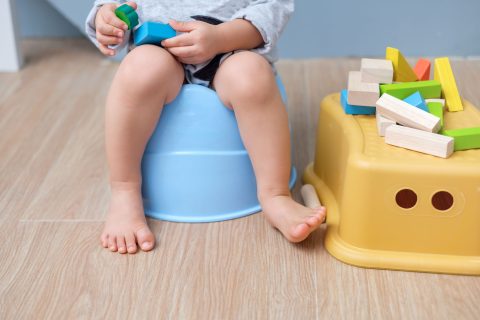In the 'grown-up toilet' all by yourself, that's exciting! Becoming toilet trained is a big milestone for your child and for you as a parent. On average, this happens between the ages of 2 and 3, but every child develops at his or her own pace. Is your child potty trained at a later age? No problem! It is especially important that you do not force your son or daughter into this development, because that can be counterproductive. How do you know when your child is ready for this big step and how can you support him or her in this? You can read it all in this blog.
When is your child ready to be toilet trained?
When your child is ready to be toilet trained, he or she will indicate this to you with various signals. Below you can read examples of these signals.
- Your child says or shows that he or she has to pee or poop
- Your child can sit and walk. When your child can push off with both feet at the same time and make a jump, the muscles are sufficiently developed and your child is physically ready to start toilet training.
- Your child shows an interest in toilet training
In addition to these signals, it is important that you as a parent or caregiver are also ready for this new phase. The correct period also plays an important role. Start in a quiet period when your child experiences little tension or fuss. For example, a period without birthdays or holidays.
Support your child on the road to toilet training in 3 steps
Through various signals that your child gives, you have noticed that he or she is ready to become toilet trained. This means that it is time to support your child in this. We also call this toilet training. Below you can read 3 steps that you can follow to support your child during his or her development towards toilet training.
Step 1: Get used to the toilet
Let your child get used to the toilet slowly. A good posture is important here; your child sits relaxed and without straining on the toilet while his or her feet are supported. Show your child that he or she does not have to perform every toilet moment. The toilet is a new room and that is quite exciting. Do you notice that your child finds this very exciting? First let him get used to the potty, but in the toilet room, so that your child gets used to the space.
Tip: booklets such as 'Carel on the potty' can help you with this.
Step 2: Regular moments on the toilet
Rest and regularity are important factors during toilet training. Therefore, allow your child to sit on the toilet without a diaper at a number of fixed times every day. It is important that your child experiences this as a pleasant moment. You can do this, among other things, by being available and letting your child sit quietly on the toilet for a few minutes.
Tip: The best times are before and after sleeping and after all eating and drinking moments or when your child indicates this.
Step 3: Diaper out
Does your child pee on the toilet during the day? Then his or her diaper can be taken off during the day. If your child also has dry diapers at night, you can also leave the diaper off overnight. Keep in mind that it will take your child longer to potty train at night than during the day.
Tip: Let your child pee before going to sleep.


